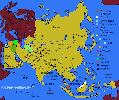|
|
|
|
|
|
|
|
|
|
|
|
|
|
| | |
|
|
|
|
| | |
| Name | latin |
Ambivia undata |
| english |
Asian twig-mantis |
| |
|
| | IGM-Number | 84 |
| |
|
| | Systematics | Super-Order |
Dictyoptera |
| Order |
Mantodea |
| Family |
Mantidae |
| Subfamily |
Vatinae |
| Tribe |
Danuriini |
| |
|
| | First Description | Author |
FABRICIUS |
| Year |
1793 |
| |
|
| Size
Quotation of Size
|
|
The given size is measured from the head to the end of the abdomen, without the wings.
|

|

| Male |
4cm - 5cm |
| Female |
5cm - 6cm |
| |
|
| Lifespan
Quotation of the Lifespan
|
|
The lifespan is given in month and has the following definition:
overall-age ("time between hatching and imago" + "lifespan after the last molting")
Example: 9 (2 + 7) month lifespan
overall-age = 9 month
time between hatching and imago = 2 month
lifespan after the last molting = 7 month
|

|

| Male |
6 (4 + 2) months / ~ 7 moltings |
| Female |
10 ( 5 + 5) month / ~ 8 moltings |
| |
|
| Sexing
Sexing
|
|
Morphologically differences between male and female.
|

|

| Male |
L5 and above: essentually thinner than females, 8 abdominal plates
adult: volant, thinner than females, wings longer than the abdomen, 8 abdominal plates, long antennas |
| Female |
L5: more compact than males, 6 abdominal plates
adult: nonvolant, more compact than males, 6 abdominal plates, short antennas |
| |
|
| | | | | Spreading | Thailand, Malaysia, North-Vietnam, Myanmar |
| |
| |
| |
|
| | |
|
|
 |
| Asia |
|
| | Habitat | bushes and shrubbes |
| |
|
| | Aggressiveness | middle to high |
| |
|
| | Colorvariants | none |
| |
|
| | Hint | In case of danger, they spread their arms far away from their body and remain in their canouflage-behavior motionless. |
| |
|
|
| |
|
|
|
|
|
|
|
|
|

